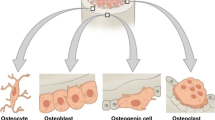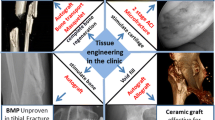Abstract
The treatment of large (6 cm) segmental bone defects, especially in areas associated with soft tissue damages and exposure, is challenging. Massive bone allografts are widely used in reconstructive surgery to replace missing bone parts such as critical size defects, nevertheless, early vascular invasion is a critical factor in bone allograft incorporation and in the consequent success of the surgery. Unfortunately, it has been proven that only slow and incomplete bone integration is possible by using frozen allografts in the treatment of large bone defects. An allogenic frozen bone graft was engineered with bone marrow mononuclear cells (BMMCs) to repair a large ulna defect in a male patient. When infection and sinus developed at the graft site 4 months after implantation, the partially reabsorbed graft was removed and send to the lab for examination. The histological and immunohistochemical analysis performed on a graft removed from the central zone of the defect demonstrated areas of neo-vascularisation, indicating that a remodelling process was actively occurring even in an area not usually repopulated with the conventional techniques. For these reasons, we may hypothesise that the use of BMMCs has a role in the re-building of large segmental defects.
Similar content being viewed by others
References
Jupiter JB, Gerhard HJ, Guerrero J et al (1997) Treatment of segmental defects of the radius with use of the vascularized osteoseptocutaneous fibular autogenous graft. J Bone Joint Surg Am 79:542–550
Ring D, Allende C, Jafarnia K et al (2004) Ununited diaphyseal forearm fractures with segmental defects: plate fixation and autogenous cancellous bone-grafting. J Bone Joint Surg Am 86:2440–2445
Grishin IG, Golubev VG, Goncharenko IV et al (1990) Transfer of free vascularized bone and skin-bone autografts. Experiences in the application of external fixation apparatus. J Reconstr Microsurg 6:1–11
DeCoster TA, Gehlert RJ, Mikola EA, Pirela-Cruz MA (2004) Management of posttraumatic segmental bone defects. J Am Acad Orthop Surg 12:28–38
Chen ZW, Yan W (1983) The study and clinical application of the osteocutaneous flap of fibula. Microsurgery 4:11–16
Yoshimura M, Shimamura K, Iwai Y et al (1983) Free vascularized fibular transplant. A new method for monitoring circulation of the grafted fibula. J Bone Joint Surg Am 65:1295–1301
Vail TP, Urbaniak JR (1996) Donor-site morbidity with use of vascularized autogenous fibular grafts. J Bone Joint Surg Am 78:204–211
Watson JT, Anders M, Moed BR (1995) Management strategies for bone loss in tibial shaft fractures. Clin Orthop Relat Res 315:138–152
Johnson EE, Urist MR, Schmalzried TP et al (1989) Autogeneic cancellous bone grafts in extensive segmental ulnar defects in dogs. Effects of xenogeneic bovine bone morphogenetic protein without and with interposition of soft tissues and interruption of blood supply. Clin Orthop Relat Res 243:254–265
Kon E, Muraglia A, Corsi A et al (2000) Autologous bone marrow stromal cells loaded onto porous hydroxyapatite ceramic accelerate bone repair in critical-size defects of sheep long bones. J Biomed Mater Res 49:328–337
Lucarelli E, Fini M, Beccheroni A et al (2005) Stromal stem cells and platelet-rich plasma improve bone allograft integration. Clin Orthop Relat Res 435:62–68
Quarto R, Mastrogiacomo M, Cancedda R et al (2001) Repair of large bone defects with the use of autologous bone marrow stromal cells. N Engl J Med 344:385–386
Salkeld SL, Patron LP, Barrack RL, Cook SD (2001) The effect of osteogenic protein-1 on the healing of segmental bone defects treated with autograft or allograft bone. J Bone Joint Surg Am 83:803–816
Walsh MC, Kim N, Kadono Y et al (2006) Osteoimmunology: interplay between the immune system and bone metabolism. Annu Rev Immunol 24:33–63
Prockop DJ (1997) Marrow stromal cells as stem cells for nonhematopoietic tissues. Science 276:71–74
Donati D, Di Liddo M, Zavatta M et al (2000) Massive bone allograft reconstruction in high-grade osteosarcoma. Clin Orthop Relat Res 377:186–194
Myerson MS, Neufeld SK, Uribe J (2005) Fresh-frozen structural allografts in the foot and ankle. J Bone Joint Surg Am 87:113–120
Bruder SP, Jaiswal N, Ricalton NS et al (1998) Mesenchymal stem cells in osteobiology and applied bone regeneration. Clin Orthop Relat Res 355[Suppl]:S247–S256
Tsuchida H, Hashimoto J, Crawford E et al (2003) Engineered allogeneic mesenchymal stem cells repair femoral segmental defect in rats. J Orthop Res 21:44–53
Williams DF (2006) To engineer is to create: the link between engineering and regeneration. Trends Biotechnol 24:4–8
Arinzeh TL, Peter SJ, Archambault MP et al (2003) Allogeneic mesenchymal stem cells regenerate bone in a critical-sized canine segmental defect, J Bone Joint Surg Am 85:1927–1935
Williams DF (2006) Tissue engineering: the multidisciplinary epitome of hope and despair. In: Patony R, McNamara L (eds) Studies in multidisciplinarity. Elsevier, Oxford, pp 483–524
Author information
Authors and Affiliations
Corresponding author
Rights and permissions
About this article
Cite this article
Giannini, S., Vannini, F., Lisignoli, G. et al. Histological and immunohistochemical analysis of an allogenic bone graft engineered with autologous bone marrow mononuclear cells in the treatment of a large segmental defect of the ulna. A case report. Chir Organi Mov 91, 171–175 (2008). https://doi.org/10.1007/s12306-007-0029-9
Received:
Accepted:
Published:
Issue Date:
DOI: https://doi.org/10.1007/s12306-007-0029-9




